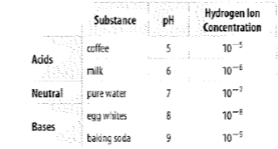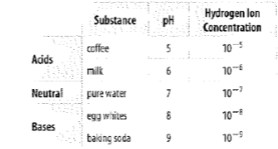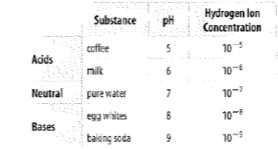
a.
To find :
a.
Answer to Problem 42IP
The hydrogen ion concentration of coffee is
Explanation of Solution
Given information :
The PH scale range from 0 to 14, with a PH 7 being neutral. As the PH decrease the substance is more acidic.

Calculation :
The greatest hydrogen ion concentration in the table is coffee because its exponent
Hence,the hydrogen ion concentration of coffee is
b.
To find : which substance has a hydrogen ion concentration of one millionth
b.
Answer to Problem 42IP
The substance would be milk.
Explanation of Solution
Given information :
The table shows the average lengths of different objects

Calculation :
Therefore the substance that has a hydrogen ion concentrated of one millionth is
c.
To find : how many times as great is the hydrogen ion concentration of coffee as the hydrogen ion concentration of pure water
c.
Answer to Problem 42IP
The hydrogen ion concentration of coffee is
Explanation of Solution
Given information :
The PH scale range from 0 to 14, with a PH 7 being neutral. As the PH decrease the substance is more acidic.

Calculation :
Therefore, the hydrogen ion of coffee is greater than pure water bye
Hence, the hydrogen ion concentration of coffee is
Chapter 4 Solutions
Glencoe Math Accelerated, Student Edition
Additional Math Textbook Solutions
Intro Stats, Books a la Carte Edition (5th Edition)
University Calculus: Early Transcendentals (4th Edition)
Thinking Mathematically (6th Edition)
A First Course in Probability (10th Edition)
Calculus: Early Transcendentals (2nd Edition)
- 3 2 1 y O a The graph of the function f is shown in the figure above. Which of the following statements about f is true? о limb f(x) = 2 Olima f(x) = 2 о lima f (x) = lim x →b f(x) → f (x) = 1 limb. lima f(x) does not existarrow_forwardQuestion 1 (1pt). The graph below shows the velocity (in m/s) of an electric autonomous vehicle moving along a straight track. At t = 0 the vehicle is at the charging station. 1 8 10 12 0 2 4 6 (a) How far is the vehicle from the charging station when t = 2, 4, 6, 8, 10, 12? (b) At what times is the vehicle farthest from the charging station? (c) What is the total distance traveled by the vehicle?arrow_forwardQuestion 2 (1pt). Evaluate the following (definite and indefinite) integrals (a) / (e² + ½) dx (b) S (3u 2)(u+1)du (c) [ cos³ (9) sin(9)do .3 (d) L³ (₂ + 1 dzarrow_forward
- = Question 4 (5pt): The Orchard Problem. Below is the graph y f(t) of the annual harvest (assumed continuous) in kg/year from my cranapple orchard t years after planting. The trees take about 25 years to get established, and from that point on, for the next 25 years, they give a fairly good yield. But after 50 years, age and disease are taking their toll, and the annual yield is falling off. 40 35 30 。 ៣៩ ថា8 8 8 8 6 25 20 15 10 y 5 0 0 5 10 15 20 25 30 35 40 45 50 55 60 The orchard problem is this: when should the orchard be cut down and re- planted, thus starting the cycle again? What you want to do is to maximize your average harvest per year over a full cycle. Of course there are costs to cutting the orchard down and replanting, but it turns out that we can ignore these. The first cost is the time it takes to cut the trees down and replant but we assume that this can effectively be done in a week, and the loss of time is negligible. Secondly there is the cost of the labour to cut…arrow_forwardnd ave a ction and ave an 48. The domain of f y=f'(x) x 1 2 (= x<0 x<0 = f(x) possible. Group Activity In Exercises 49 and 50, do the following. (a) Find the absolute extrema of f and where they occur. (b) Find any points of inflection. (c) Sketch a possible graph of f. 49. f is continuous on [0,3] and satisfies the following. X 0 1 2 3 f 0 2 0 -2 f' 3 0 does not exist -3 f" 0 -1 does not exist 0 ve tes where X 0 < x <1 1< x <2 2arrow_forwardNumerically estimate the value of limx→2+x3−83x−9, rounded correctly to one decimal place. In the provided table below, you must enter your answers rounded exactly to the correct number of decimals, based on the Numerical Conventions for MATH1044 (see lecture notes 1.3 Actions page 3). If there are more rows provided in the table than you need, enter NA for those output values in the table that should not be used. x→2+ x3−83x−9 2.1 2.01 2.001 2.0001 2.00001 2.000001arrow_forwardFind the general solution of the given differential equation. (1+x)dy/dx - xy = x +x2arrow_forwardEstimate the instantaneous rate of change of the function f(x) = 2x² - 3x − 4 at x = -2 using the average rate of change over successively smaller intervals.arrow_forwardGiven the graph of f(x) below. Determine the average rate of change of f(x) from x = 1 to x = 6. Give your answer as a simplified fraction if necessary. For example, if you found that msec = 1, you would enter 1. 3' −2] 3 -5 -6 2 3 4 5 6 7 Ꮖarrow_forwardGiven the graph of f(x) below. Determine the average rate of change of f(x) from x = -2 to x = 2. Give your answer as a simplified fraction if necessary. For example, if you found that msec = , you would enter 3 2 2 3 X 23arrow_forwardA function is defined on the interval (-π/2,π/2) by this multipart rule: if -π/2 < x < 0 f(x) = a if x=0 31-tan x +31-cot x if 0 < x < π/2 Here, a and b are constants. Find a and b so that the function f(x) is continuous at x=0. a= b= 3arrow_forwardUse the definition of continuity and the properties of limits to show that the function is continuous at the given number a. f(x) = (x + 4x4) 5, a = -1 lim f(x) X--1 = lim x+4x X--1 lim X-1 4 x+4x 5 ))" 5 )) by the power law by the sum law lim (x) + lim X--1 4 4x X-1 -(0,00+( Find f(-1). f(-1)=243 lim (x) + -1 +4 35 4 ([ ) lim (x4) 5 x-1 Thus, by the definition of continuity, f is continuous at a = -1. by the multiple constant law by the direct substitution propertyarrow_forwardarrow_back_iosSEE MORE QUESTIONSarrow_forward_ios
 Calculus: Early TranscendentalsCalculusISBN:9781285741550Author:James StewartPublisher:Cengage Learning
Calculus: Early TranscendentalsCalculusISBN:9781285741550Author:James StewartPublisher:Cengage Learning Thomas' Calculus (14th Edition)CalculusISBN:9780134438986Author:Joel R. Hass, Christopher E. Heil, Maurice D. WeirPublisher:PEARSON
Thomas' Calculus (14th Edition)CalculusISBN:9780134438986Author:Joel R. Hass, Christopher E. Heil, Maurice D. WeirPublisher:PEARSON Calculus: Early Transcendentals (3rd Edition)CalculusISBN:9780134763644Author:William L. Briggs, Lyle Cochran, Bernard Gillett, Eric SchulzPublisher:PEARSON
Calculus: Early Transcendentals (3rd Edition)CalculusISBN:9780134763644Author:William L. Briggs, Lyle Cochran, Bernard Gillett, Eric SchulzPublisher:PEARSON Calculus: Early TranscendentalsCalculusISBN:9781319050740Author:Jon Rogawski, Colin Adams, Robert FranzosaPublisher:W. H. Freeman
Calculus: Early TranscendentalsCalculusISBN:9781319050740Author:Jon Rogawski, Colin Adams, Robert FranzosaPublisher:W. H. Freeman
 Calculus: Early Transcendental FunctionsCalculusISBN:9781337552516Author:Ron Larson, Bruce H. EdwardsPublisher:Cengage Learning
Calculus: Early Transcendental FunctionsCalculusISBN:9781337552516Author:Ron Larson, Bruce H. EdwardsPublisher:Cengage Learning





